

Science and Sunsets
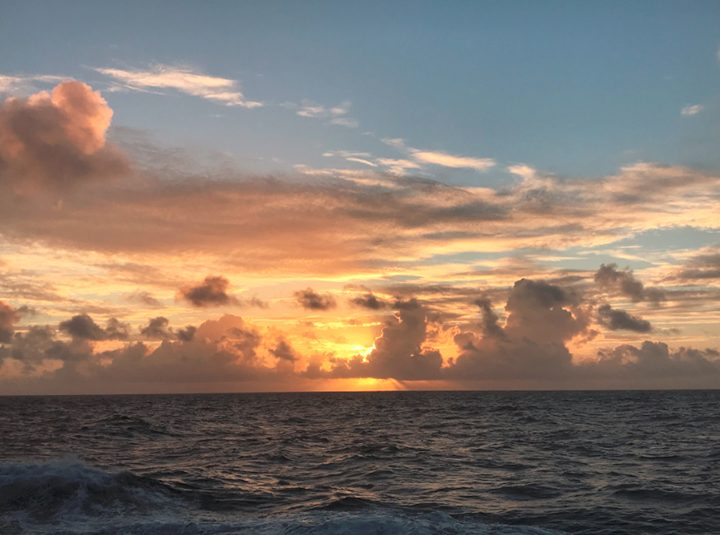
Sunset captured on board the R/V Atlantis during NAAMES 4.
Day 10 and two stations into the last NAAMES campaign. It feels like we were just on the dock in Puerto Rico preparing for our 25-day adventure on the R/V Atlantis. The anticipation for NAAMES 4 was great. Many relationships were formed during NAAMES 3 and getting on the Atlantis for NAAMES 4 felt like returning to a familiar place. Everyone was excited to see old faces and eager to greet the new additions. While the cruise is filled with long hours and tedious experiments, we are still able to find time to unwind with each other. The long transit to our first station from Puerto Rico gave us a chance to spend time with each other before the chaos of stations began. There were large groups for watching sunrises and sunsets. The sunset watching often includes playing music and singing along with your fellow shipmates! Not to mention many people bring along instruments to play while onboard.
One of the best parts of being involved in a field campaign like NAAMES is the ability to hear about each other’s research and try to find ways to collaborate. Ultimately the reason we are all willing to put our lives on hold for an entire month is the excitement of the unknown. We are not sure what the results will be from the cruise or how the data will fit into the NAAMES story that has already been started by campaigns 1-3. Each group has something to contribute to the overall understanding of the effects of a phytoplankton bloom in the North Atlantic Ocean.
Our group from Texas A&M University is focused on studying marine aerosols. We have instruments in a van on the ship that are taking samples. One of our main goals is to count the number of particles going through our system and determine the number of these particles that can activate as cloud condensation nuclei (CCN). This is just one small area of research taking place onboard the Atlantis. We are eager to work together with other groups on the ship and compare results. With so much left to answer there is a lot of work that needs to be devoted to our research. What keeps us going through the long hard days on the ship? Our love of science and sunsets.
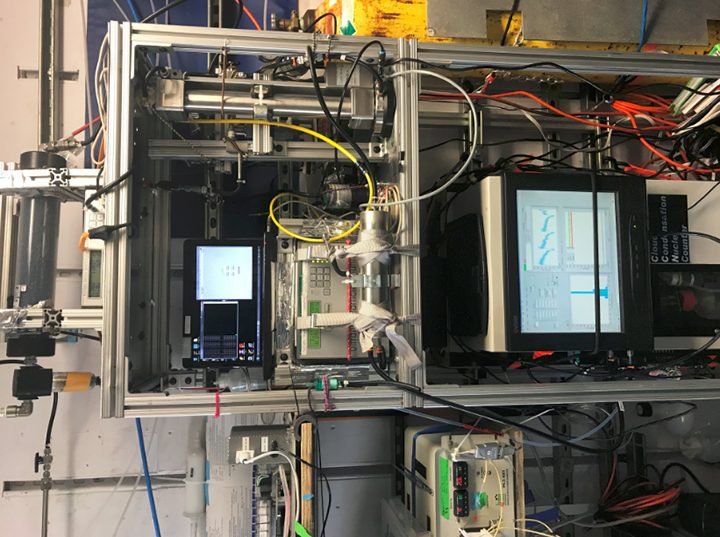
Aerosol instrumentation from Texas A&M University.
Written by Bri Hendrickson
A day at Sea
1.14PM. The sun is high in the sky. I am enjoying its energizing warmth on the bow. Only the wind is keeping me company with its mild whistling.
1.14PM. Ten hours of work have already passed by. Fast, very fast. The alarm goes off at 2 AM. Eyes wide open. Take a quick shower. Run to the computer lab. Check the water profile following in real time the sensors going down into the dark ocean. Pick the most representative depths for the water dynamics we want to capture aaaand…COFFEE. One, well maybe two cups, and the show is on! The rush to get the experiments setup before sunrise, the frentic collection of samples under dim light so as to not interfere with the biological processes of plankton, the labeling, the filtering and fixing of hundreds of samples. The instruments all over the biology main lab start whirling, pumping, aspirating, shooting with lasers and cameras all sorts of samples. The computers start showing an incredible variety of data, numbers, plots, and pictures of our tiny friends that will help us unravel the complex and amazing world of plankton and its relations with atmospheric processes.
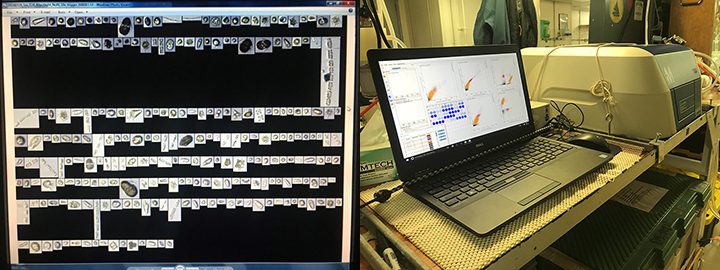
Compositional characterization of nano- and microplankton produced by the FlowCam (left picture), and data analysis of the smaller planktonic components (right picture) on the Guava FlowCytometer.
All of a sudden someone yells: “science meeting in five” and you realize that nine hours have passed by. Nine very intense hours. Balancing efficiency and accuracy to produce good science with laughs exploding randomly here and there, dance steps, singing and passion, tons of passion for our job, for the trill of the discovery, for the opportunity we have to contribute to expand the understanding of processes that made and keep this planet habitable. So, at 11 sharp we all converge to the library where Mike, our Chief Scientist, will share with us the latest satellite images of the ocean forecast, the most recent data transmitted by the floats we released during the last field campaign on the dynamics we will find at our next station, and the essential Plan Of the Day, detailed schedule of the daily operations that allows this complicated scientific operation to run smoothly, joyful and productive for 26 days straight out in the middle of the North Atlantic!

The Menden-Deuer Lab Team at work at Station 2 during NAAMES IV.
From left to right: Caitlin Russell, Gayantonia Franzè, Françoise Morison.
Written by Gayantonia Franzè

On March 14, four members of the NASA ABoVE Dall sheep project (lead PI Laura Prugh and PhD students Chris Cosgrove, Ryan Crumley, and Molly Tedesche) headed into the Wrangell Mountains for a week-long field expedition to conduct snow surveys. These snow surveys are critical to the project’s goal of understanding how snow conditions are changing and affecting Dall sheep in northern alpine regions. Riding snowmobiles for more than 20 miles into the wilderness, breaking trail and clearing brush for the last 5 miles (and sometimes getting stuck), the crew set up base camp in an open meadow. It turned out this meadow was home to a resident bull moose, who kept a respectful distance and was often seen browsing nearby. Snow levels were unusually high this year, making for a useful contrast to last year’s surveys and giving team members a good snowshoeing workout. Navigating through deep snow, thick brush, and over steep terrain, the team recorded snow depth using a Magnaprobe, dug snow pits to examine the snowpack stratigraphy (layering over the season), and measured snow track sink depths of Dall sheep and one of their main predators, coyotes. The team was able to reach 17 of the 22 sites that had been established in September to record snow depth every hour using game cameras and snow stakes; the remaining 5 sites were in terrain that was unsafe to reach due to avalanche danger.
The team’s luck with clear, warm weather broke on the last day of fieldwork. Amid a snowstorm that was picking up momentum, Prugh spotted an area with a maze of coyote tracks and what appeared to be the faint traces of white fur on the snow. Investigation confirmed the site was a sheep kill, and Prugh quickly dug a pit to record the snow characteristics that may have contributed to the sheep’s demise. Perhaps the snow was dense enough for the coyotes to run on top of the snowpack, whereas the sheep, with a heavier body mass and small hooves, floundered in the deep snow?
Fortunately, the snowstorm ended overnight, and the crew awoke to blue skies overhead and 8 inches of fresh powder blanketing the spectacular landscape. Analysis of the field data over the coming year will improve efforts to model and map snow characteristics across the mountainous region, and reveal how snow properties affect the vulnerability of Dall sheep to predation.
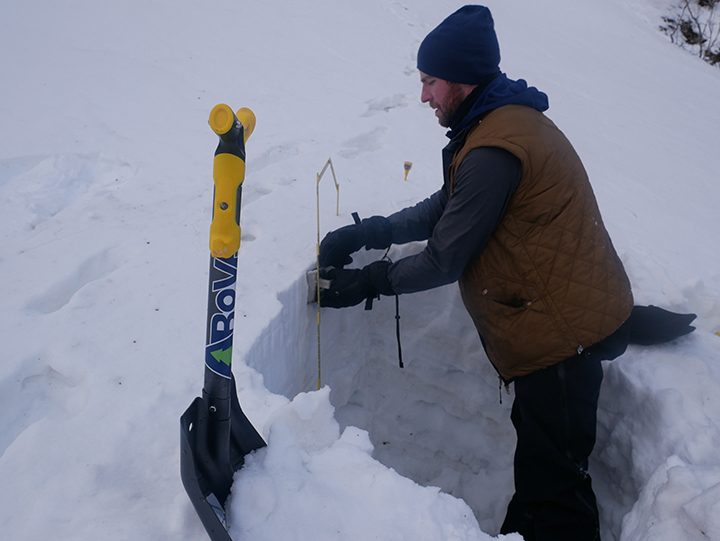
PhD student Chris Cosgrove (Oregon State University) measures snow density adjacent to Dall sheep snow tracks.
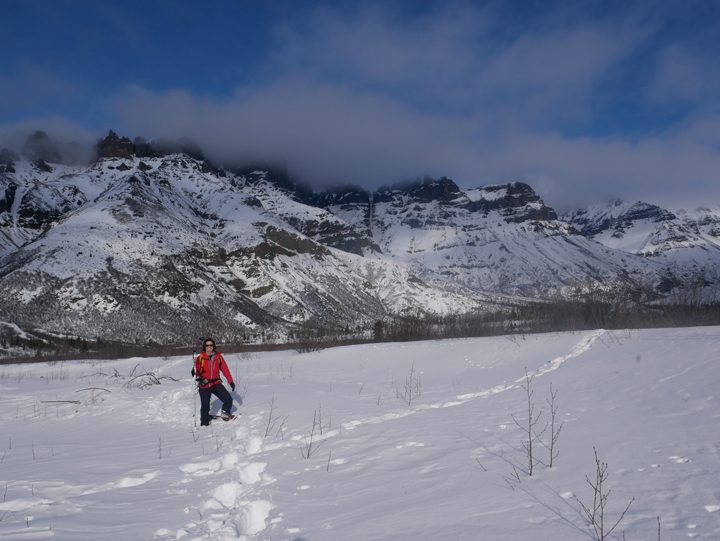
PI Laura Prugh (University of Washington) using a Magnaprobe to measure snow depth.
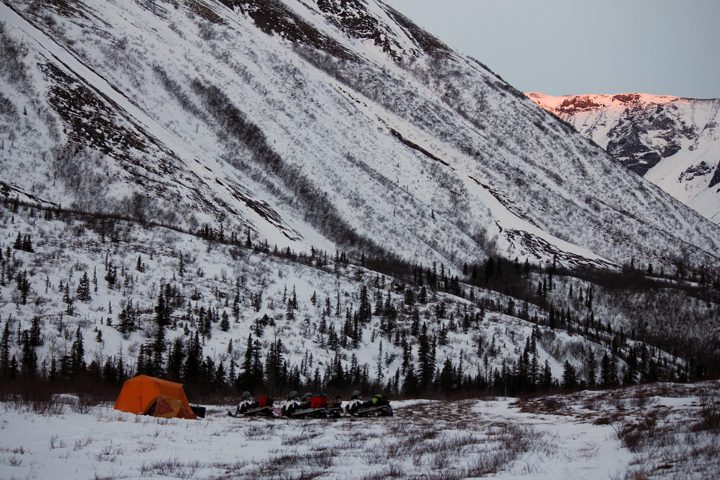
Winter camp in Wrangell St. Elias National Park. Snowmobiles, Arctic Oven tent, and winter camping gear was provided by the ABoVE Fairbanks Logistics office.


Snowmobiling expedition in the Wrangell mountains to conduct snow surveys.
Marker Mark and Recapture
Transit was long.
I used it to design a deeply elegant experiment — elegance is the true mark of a good experiment, where a complex problem is broken down into a simply testable idea or procedure — to address one of the most profound questions in science: Where do all of the Sharpies go on a research cruise?
The approach was simple. We would do a mark-recapture experiment to: i) estimate the total black Sharpie population on board and ii) map changes in the distribution of permanent markers as we approached the end of our pre-sampling preparatory period.
A mark-recapture is a very versatile technique. I advise readers to use it for all kinds of common questions: how many socks actually live in my house? At what rate do all of my Oreos migrate towards my roommates bedroom? Which toys does my cat move around in the night?
Essentially, you capture and count a sub-population of something (markers, fish, tigers, socks, cat toys – some of these are harder to subjugate than others) and mark them in a pretty permanent way. Then, as with all the things we love, you set them free. You wait some civilized amount of time dependent on what your question and your target population, and then set out to recapture and count them again.
The idea is that the frequency with which you encounter marked items/organisms is proportionate to the size of the total (i.e., marked and unmarked) population of items or organisms of interest. The more frequently you encounter a marked item compared to unmarked ones, the smaller your population. The less frequently, the larger. You can also map the distribution of your marked items compared to the original distribution to determine how far your target populations travel, how large their home range is, etc.
So, we broke out the Sharpies. We borrowed some delightfully red nail polish from our collaborator Gaya. We painted discrete patches of nail polish on the lids of ten markers, and then we set them free. They looked quite nice, really (Figure 1). To encourage dispersal, we left the Sharpies spread all over the benches so that any passerby would assume we had far too many, and that some should come with them. I am a little embarrassed to say that a lot of thought went into all of this.
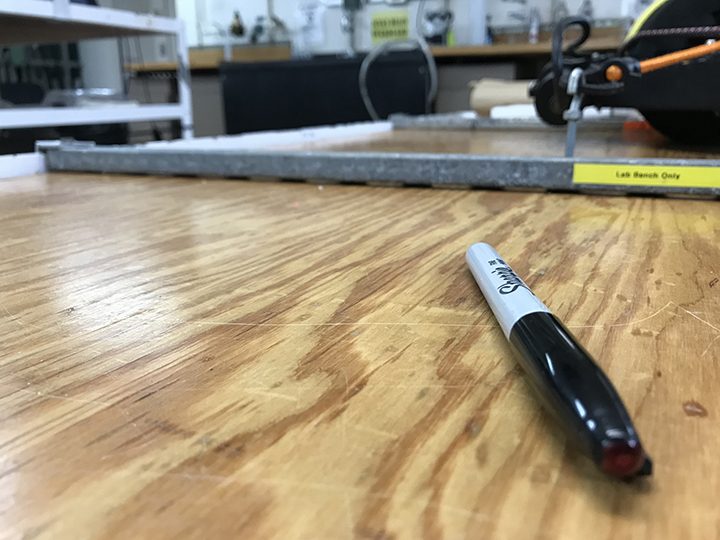
Figure 1. A sharpie marked for recapture.
On Night One post-liberation, nothing happened. This was alarming — I had hypothesized that they all would be gone. It was so thrilling to be so wrong! For the next two days, we used the Sharpies as part of our work, but still, none left the home range of our benches.
After three days, we called it off, having made three key findings:
Taken together, we found no evidence that Sharpies migrate during research cruises, at least during pre-sampling periods. It seems likely that the loss of markers is a seasonal process: while we observed no loss during pre-sampling, perhaps their loss processes accelerate during other phases of the cruise. Repeating the experiment during our sampling period and on our transit home is almost certain to yield very different results, and reconcile the lack of loss here with the established pattern of Sharpie loss.
Finally, while it is clear that any loss of markers from our bench during the rest of the cruise would be detrimental because our own Sharpie supply is seemingly minimal, us taking markers from almost any other bench would not induce any noticeable harm on other researchers, infinitely inundated with markers as they are. Very useful indeed.
As a viral ecologist, I found this experiment to be quite enlightening. We don’t think that viruses can actively move, just like permanent markers. We think that markers need humans and that viruses need hosts to move around. However, in this experiment we couldn’t get even markers — something that people want to engage with — to move. How are viruses, those most precious of creatures, ever meant to stand a chance in a world where hosts are actively seeking to avoid them? I just don’t think that we have a good idea of what is going on here.
I came into this experiment full of the confidence of logic: ‘markers disappear, so I will design an experiment to elucidate how’. But I was wrong in some way I still don’t fully understand. The confidence of logic does that to you. It whispers answers in your ear so confidently that you don’ take the time to read or understand the whole question. It reminds me of the Bob Dylan line from the song Desolation Row ‘they’ll kill him with self-confidence after poisoning him with words’.
I’ve been turning these thoughts over in my head for days, seeking an answer for how I got so wrong. Maybe Sharpie loss processes occur on a different time scale than the days I had studied? Maybe they occur on some cruises but not others (if so, why?)? Maybe there are areas of massive marker loss and areas of complete stasis? If so, what characterizes these neighborhoods (perhaps the pace of Sharpie usage in these areas)? How many people picked up markers and then put them back? Imagine if the marked Sharpie were lethal viruses instead, and everyone who picked one up died — how would the viruses ever get around?
I never thought that I would end up drawn this deeply into marker dynamics, but honestly, this stuff is cool!! I love to be wrong. It means that there is a lot further to travel before understanding dawns. I am so glad I did this experiment.
Written by Ben Knowles
Fourth and Ten (+ One)
Fourth:
We are currently at the first station to be occupied by the fourth and final NAAMES field campaign. It is a bittersweet experience both scientifically and personally. This station represents the final push of an epic joint exploration of marine and atmospheric sciences made possible by the thoughtful investigators who wrote the interdisciplinary proposal; a proposal that NASA found compelling enough to fund and was ultimately made possible by politicians and taxpayers who know that we move society forward through scientific endeavors. I would be amiss not to mention the crew(s) of the R/V Atlantis, our mother ship for all campaigns, who provided a professional, safe, and inviting atmosphere for what must seem like slightly controlled chaos to take place.
As participants we look back and see what we have done right, evaluate and discuss our amazing findings, and feel proud of our contributions to the larger fields of marine and atmospheric sciences. We also have enough hindsight from the past few years to look back and see what we will do even better next time. For many of us, it also represents an era in our careers, ranging from providing the experience and data to build and help finish graduate degrees, bolstering mid‐career scientists, and providing fresh ideas and avenues of exploration to more seasoned scientists. It will, and has already, created new collaborations, publications, proposals, and challenging concepts to tackle in the future.
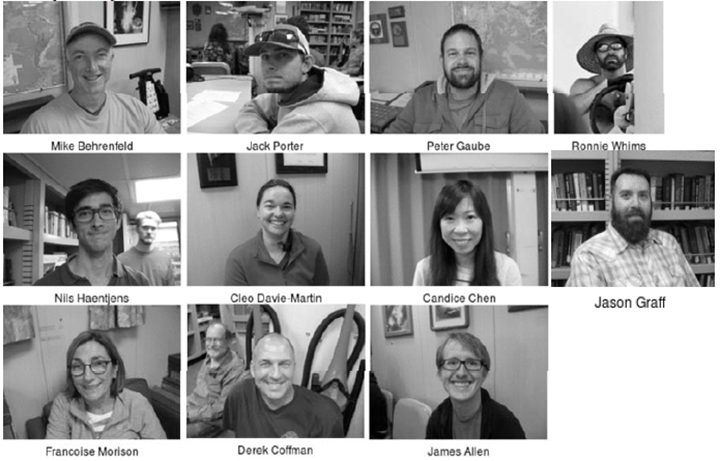
The ten scientific crew and one ship’s personnel who have participated in all 4 NAAMES campaigns.
That is the number of people, both scientific (10) and ship’s personnel (1), who have participated in all 4 of the seagoing campaigns. What the ten people pictured above represent is the consistency between cruises that is critical to the successful training of new team members and implementation of the planned science. What is not represented above are the countless people who were here for 1, 2, or 3 voyages who bring fresh personalities, flavors to the galley, and ideas that can motivate, enlighten, and ignite new relationships and scientific curiosities. “Thank you!” to those on the ship, in the air, and on the ground who made all of this possible and successful.
Written by Jason R. Graff